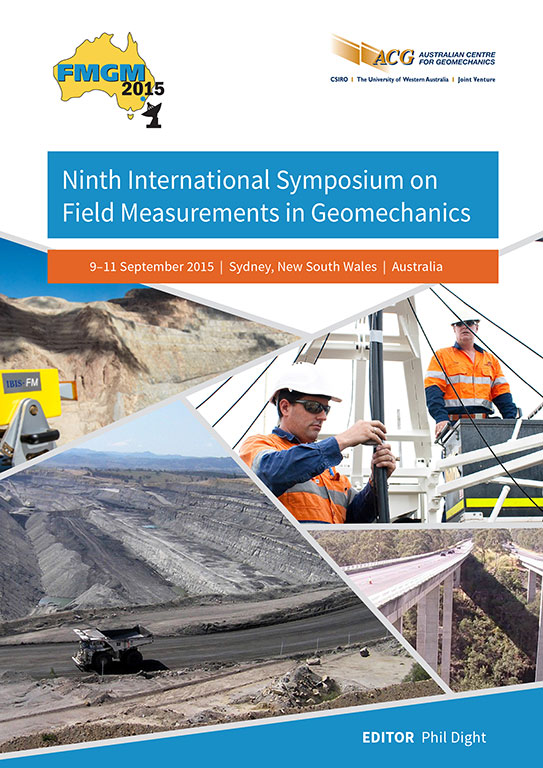InSAR-derived time series analysis of tunnel construction-induced ground deformation in urban landscapes

|
Authors: Macdonald, B; Iannacone, JP; Falorni, G; Gianniaco, C Paper is not available for download Contact Us |
DOI https://doi.org/10.36487/ACG_rep/1508_19_Macdonald
Cite As:
Macdonald, B, Iannacone, JP, Falorni, G & Gianniaco, C 2015, 'InSAR-derived time series analysis of tunnel construction-induced ground deformation in urban landscapes', in PM Dight (ed.), FMGM 2015: Proceedings of the Ninth Symposium on Field Measurements in Geomechanics, Australian Centre for Geomechanics, Perth, pp. 315-328, https://doi.org/10.36487/ACG_rep/1508_19_Macdonald
Abstract:
Transportation corridors have reached capacity in many municipalities worldwide. To provide the extra capacity to serve growing populations, civic planners have turned to tunnelling for utility services and public transport. These tunnels are located under established urban and downtown core infrastructure. Tunnelling methods include cut-and-cover, traditional tunnel excavation and tunnel boring machines (TBM). Each method can have a different effect on the surface stability of the established in situ infrastructure depending on depth and substrate materials. Interferometric synthetic aperture radar (InSAR) is well suited to monitor the surface displacement resulting from these tunnelling activities. The advances in satellite radar coverage and InSAR processing techniques have led to millimetre accuracy in capturing ground displacement. City landscapes provide good radar targets with sample point densities ranging in the 10s of thousands per square kilometre without the need for ground instrumentation. Three tunnel monitoring case studies are presented showing monitoring of cut-and-cover, traditional excavation and TBM projects. The results over one metro line, one inter-urban rail line and one water utilities project are presented. InSAR provided an effective solution to analyse the evolution of the surface topography and the impact on infrastructure during the different stages of the tunnel projects. In each case, a strong spatial and temporal correlation between the settlement initiation and the timing of tunnel excavation was examined. The full coverage of the monitoring area also identified deformation in areas that were not adjacent to the excavation work, nor expected.
References:
Armstrong, JE 1990, Vancouver geology, Geological Association of Canada, Vancouver.
Bitelli, G, Bonsignore, F & Unguendoli, M 2000, ‘Levelling and GPS networks for ground subsidence monitoring in the southern
Po Valley’, Journal of Geodynamics, vol. 30, no 3, pp. 355-369.
Brox, D, Phelps, D, Garrod, B, Morrison, T & Saltis, A 2007, ‘Construction update and TBM excavation Seymour Capilano Twin Tunnels Project, in J Barták, I Hrdina, G Romancov & J Zlámal (eds), Underground space — the 4th dimension of metropolises, CRC Press, Boca Raton, FL, pp. 1119-1123.
Brox, D, Procter, P, Pringle, J, Garrod, B, Morrison, T & Saltis, A 2005, ‘The Seymour Capilano Twin Tunnels Project, Proceedings of the Rapid Excavation and Tunneling Conference, Society for Mining, Metallurgy & Exploration, Englewood, CO, pp. 94-104.
Brox, D, Rotzien, J, Genschel, C, Messner, J, Gupta, A, Morrison, T & Saltis, A 2006, ‘Construction update and TBM excavation planning Seymour Capilano Twin Tunnels Project, Vancouver’, Proceedings of the 2006 Tunnelling Association of Canada, Richmond, British Columbia.
Burland, JB 1995, ‘Assessment of risk of damage to buildings due to tunnelling and excavation’, Proceedings of the 1st International Conference on Earthquake Geotechnical Engineering (IS-Tokyo ’95), pp. 1189-1201.
Burland, JB & Wroth, CP 1974, ‘Settlement of buildings and associated damage’, in Settlement of structures, British Geotechnical Society, Pentech Press, London. pp. 611-654.
Carminati, E & Martinelli, G 2002, ‘Subsidence rates in the Po Plain, Northern Italy: the relative impact of natural and anthropic causation’, Engineering Geology, vol. 66, pp. 241-255.
Ferretti, A, Fumagalli, A, Novali, F, Prati, C, Rocca, F, & Rucci, A 2011, ‘A new algorithm for processing interferometric
data-stacks: SqueeSAR’, Geoscience and Remote Sensing, IEEE Transactions, vol. 49, no. 9, pp. 3460-3470.
Przyłucka, M, Herrera, G, Graniczny, M, Colombo, D & Béjar-Pizarro, M 2015, ‘Combination of conventional and advanced DInSAR to monitor very fast mining subsidence with TerraSAR-X data: Bytom City (Poland)’, Remote Sensing, vol. 7, no. 5,
pp. 5300-5328.
© Copyright 2025, Australian Centre for Geomechanics (ACG), The University of Western Australia. All rights reserved.
View copyright/legal information
Please direct any queries or error reports to repository-acg@uwa.edu.au
View copyright/legal information
Please direct any queries or error reports to repository-acg@uwa.edu.au